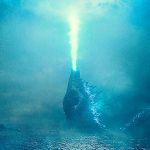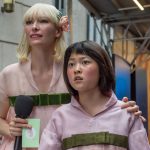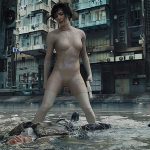The last English language version of Godzilla came out sixteen years ago, before a portion of this year’s target audience were born. Now Gareth Edwards (Monsters) goes back to the Japanese roots of the franchise with a special effects extravaganza that, for a while at least, manages to put characterisation and the human dimension in the foreground for an engrossing first hour. After that, the special effects and the familiar tale of destruction by giant monsters take over. The kids will love it.
The original Godzilla was released by Japan’s Toho Company in 1954 (directed by Ishiro Honda) and spawned 27 further films, remaining, despite US remakes and merchandising, a Japanese franchise and with cause. Now Godzilla is a portrayed as a more sympathetic creature, a victim himself of man’s tampering with nature and a defiant, self-defending hero with its own star on the Hollywood Walk of Fame. But in 1954, less than a decade after the bomb was dropped on Hiroshima and Nagasaki, he was a frightening symbol of the United States and a metaphor for nuclear weapons.
Edwards and scriptwriter Max Borenstein wisely bring the action back to Japan and reinstate the connection between Godzilla and nuclear energy. After a series of newsreels to ground the action in reality, we cut to the Philippines. Two government scientists, Dr Serizawa (Watanabe), a Godzilla expert, and Dr Graham (Hawkins), are called in to investigate a remote mine in the jungle that has collapsed killing 40 workers. Inside rescue crews found fossilized radioactive remains.
Graham and Serizawa realise that they are in a huge cave that once encased the carcass of a giant creature. From their chopper they (and we) see that a large trench leads from the cave to the ocean. Could the creature have made his way to Japan via that route?
We soon find out when the film cuts to Janjira, Japan, 1999. Joe Brody, an American nuclear engineer, lives near the Janjira nuclear power plant with his scientist wife, Sandra (Juliette Binoche) and their son, Ford (CJ Adams). He is extremely concerned about the unexplained irregular frequency patterns in tremors that his colleagues attribute to earth quakes. It’s Joe’s birthday but what follows is not the celebration he had in mind when tragedy strikes at the plant and his happy life is destroyed.
Ford Brody (Taylor-Johnson, Nowhere Boy) grows up to be a tall, handsome bomb disposal expert in the military. When he isn’t in danger zones, he lives in San Francisco with his wife, Elle Brody (Elizabeth Olsen, In Secret), a nurse, and a young son. Estranged from his father who lives as a recluse in Japan, Ford is encouraged by Elle to fly to Japan when his father needs him.
To Ford’s annoyance, he finds that Joe is still obsessed with the explosion at the Janjira plant and babbles on about hearing sounds from the radioactive sites. He tells Ford that what happened in 1999 was no natural disaster and could recur. Ford accompanies his father to the ruins of their home when another terrible accident occurs. By now even Ford concedes that his father was right all along. For fifteen years something alive has been feeding on the plants’ nuclear reactors and it seems to have awoken!
Well, that’s the engrossing first hour, which is superbly done, integrating a dramatic human story with pseudo science that paves the way for the monster fights to follow. While Taylor-Johnson as Ford, Hawkins as Dr Graham and the always wonderful Ken Watanabe move along with the action, something dies with Cranston’s Joe Brody out of the picture.
The filmmakers up the ante by putting Godzilla on a collision course with two nasty giant breeding mosquitoes who conspire to kill him as all them race toward sources of nuclear power. You have to pay close attention to figure this out, if indeed I ever did. What’s clear is that bridges, trains and entire cities are destroyed along the way, which adults, aware of the cost of the clean-up, might find depressing and tedious rather than exciting.
Although Godzilla is animated to resemble a giant combination Stegosaurus and Tyrannosaurus Rex (special attention was paid to getting the original 1954 ‘roar’ updated properly), the word Godzilla is a combination of the Japanese words for gorilla and whale, which explains his power and ability to swim. But whales are social animals with large brains and men are descended from gorillas. There is surprisingly little in the story involving the ‘personality’ of Godzilla, his torment, and his relationship with humans.
Joyce Glasser – MT film reviewer




